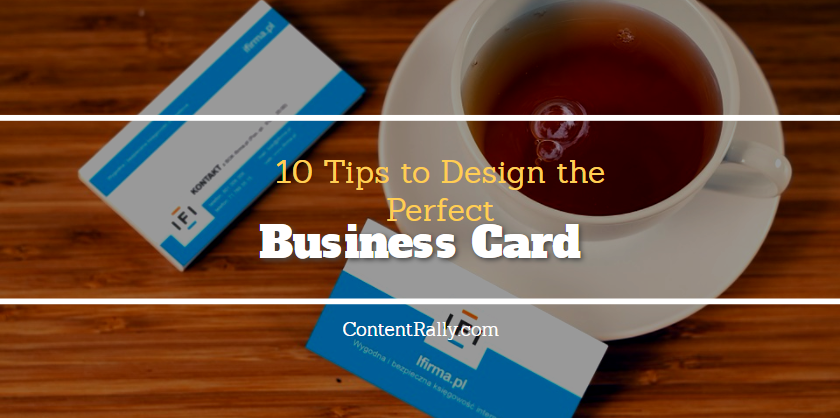Tag: Personal Branding Online

10 Tips to Design the Perfect Business Card
Handing out business cards is a good way to promote your brand and foster personal connections. But, the creation of perfect and memorable cards clearly remains a challenge. Research shows: 88%—or 9 out of 10—of distributed business cards will be thrown out within one week. How to Design the Perfect Business Card So, what makes these tangible objects impressive? A lovely design. The perfect business card doesn’t only present your contact information. It also communicates your brand’s professionalism. So, if you’re interested in making a positive impression, consider the business card design tips below. 1. Adhere to the Principles of Good Design The perfect business card is a visual representation of your brand. It’s a determining factor in whether people trash your card. And, the following elements of good design are important in capturing people’s attention: Alignment and length Color scheme Content hierarchy Typography Kern Layout Tracking White Space 2. Avoid Complexity in Design When designing the perfect business card, you should aim for simplicity. Simplicity in color and contrast to prevent overwhelm. Simplicity in fonts to prevent difficulty in reading. Remember, you want a prospect or customer to reach out to you for help with their needs. And, by avoiding complexity, you make it easy for them to read your contact information, call your number, and partner with you for your services. 3. Provide Key Information Above, we discussed simplicity in design. And, you can keep it simple by only presenting the information required to communicate who you are, what you do, and how to contact you. Details such as: Name Title, role, or function Business name and logo Physical address Telephone number If space allows, for social connections, you can also add virtual information. For instance, you can include: Professional e-mail address Website landing page or blog address One or two professional social media handles QR code 4. Emphasize Benefit and Value You should also take it a step further and emphasize your benefits. In other words, the perfect business card should do two things: Tell (or remind) people about what you can do for them Tell (or remind) people about the value you offer Limit your explanation to a line or two, describing your service, specialization, and value statement. 5. Consider a Nontraditional Shape Can you choose the standard 3.5x2 inch horizontal rectangle/square? Yes. But nowadays, you also have more creative options available. With die-cuts, for example, you can choose from a variety of shapes: Circle Folded Half-Circle Leaf Oval Rounded Corners Single Rounded Corner Slim Vertical 6. Improve Your Card’s Appearance Additionally, you can improve the look and feel of your business card, through imprinting. Again, you have several methods to choose from: CMYK or Four-Color Printing Embossing Debossing Foil Stamping PMS or Pantone Matching System Depending on your chosen imprint, “finishes”—such as lamination, UV, and spot coatings—can also positively enhance your card’s quality and design. 7. Invest in High-Quality Materials Presentation is an important part of designing the perfect business card. And, the quality of your chosen material impacts your brand’s impression. You have a few choices, when choosing your card’s paper, weight, and thickness: regular, plastic, textured, thick, thin. But, high-quality material is a better investment. How do we know? The National Institutes of Health’s research on haptic sensations found: physical touch can influence the impressions and thoughts formed about people and situations. 8. Ensure Branding Consistency What you shouldn’t do, when designing your business card, is display a lack of cohesion in branding. If there are style, color, and typography inconsistencies in your marketing materials, then people will notice. Remember, your brand identity helps customers and prospects recognize your business. And, when consistent, your business cards reinforce your visual elements. 9. Double-Check for Errors and Unreadable Text You want customers to take you seriously. To trust you. So, double-checking your business cards, before printing, is critical. Read, reread, and edit. Search for spelling, punctuation, grammar, layout, and omission mistakes. But, don’t stop there. Also, make sure your business card is readable by: Using at least 8 point fonts Using font colors complementary to its background 10. Beware Printing Specifications When designing the perfect business card, you must ensure optimal printing. Many printers stop at a certain point. So, it’s important to consider the following specifications: Bleed Area. You should include at least a 1/8” bleed area as it eliminates white space during printing. Safe Area. The center of the business card is the safe area, so you want all your readable text and graphics there. Ready to Design Your Card? Now, you're armed with 10 good design tips for creating the perfect business card. Use this Vistaprint coupon code to save on your next order. Will you apply them? If so, you'll have what you need to increase your brand awareness, make a memorable impression, and even attract new clients. Read also: 7 Big Myths About Small Business Growth Tips For Small Businesses To Raise Funds For Their Projects
READ MOREDetails
How Personal Branding Online Can Help Your Job Search
Every day, you see brands, you wear brands, you use brands, and you eat and drink brands. Business branding is everywhere. You are also a brand. Personal branding is especially useful when you’re job hunting or promoting yourself for other reasons. It’s up to you to craft your personal brand so that it conveys what you want it to convey. What is a personal brand? Your personal brand is the combination of factors that create an impression of you in the minds of other people. It’s your values, strengths, personality, passions, and all the other characteristics that people see in you. You don’t need a logo, and your resume is only a part of your personal brand. You are a complete package. When you develop your personal brand, you shape it to help your best qualities stand out. You can shape it differently for different purposes to show employers and others who you are. How a personal brand can help you How many times have you had what you thought was a successful job interview, knowing that you were fully qualified for the job – and you didn’t get it? It used to be that a good resume and a suitable personality were all you needed to get the job you wanted. These days, employers look further. When they research applicants online, they may find LinkedIn profiles, Facebook profiles, articles that you wrote, questionable photos, snide remarks on Twitter that you posted, and so on. In fact, almost 80 percent of recruiters are required to look into your online reputation to see if there are any red flags. Your personal brand helps you set yourself apart from others. Chances are that your competitors have already built their personal brands, making it easier for hiring managers to make decisions about them. One of them may have been hired for your dream job. A well-developed personal brand can also help you with these endeavors: Getting job promotions Having recruiters notice you Receiving recognition in your field Developing industry connections Attracting clients Strengthening your desirable qualities Reaching your goals more easily How to develop a personal brand First, identify the elements of your personal brand. You are a brand product, and you need to know how to describe it. You need to know what skills, strengths, talents, and experience you offer, what accomplishments show what you can do for others, and what are your core values and passions are. You need to be able to explain your goals and decide what you want to people to recognize you for. The answers to those questions form the unique package that is you. Once you’ve identified these traits, you need to package and publish them. There’s a bunch of different ways to go about this. LinkedIn is a key part of your personal brand. Prospective employers and clients will look for you and expect to see you there. Spend time writing a profile that shows off your personal brand. Review and update it regularly. Take part in LinkedIn discussions. Quality contributions will make people notice you and view your LinkedIn profile. Create profiles and take part in other social media platforms as well. Keep personal posts private so that professional connections see only posts that contribute to your personal brand. Applicants who have a personal website are more likely to be hired than those who don’t have one. Use your website to draw attention to your accomplishments, and keep it updated. If you write well, consider having a blog. A blog with industry-relevant articles can go a long way to building your credibility and attracting job offers. How to use your personal brand Now it’s time to create a resume that highlights the characteristics that form your personal brand. Use it to help employers understand your unique qualities that are relevant to their needs. Today’s resumes are more than lists of past jobs and responsibilities. Start your resume with a personal statement that describes your brand and what you offer of value to employers. Have a bulleted list near the top of the first page with accomplishments that illustrate your proficiency. Hand in hand with resume writing is researching target employers. Read their job ads carefully, and shape each resume to underscore the aspects of your personal brand that can best meet their challenges. Research jobs not only on large aggregate sites but also on local job boards. If you live in New York, for example, search the ads for jobs in your field at New York Jobs. You can also post your resume online. Choose a version that will appeal to the majority of employers you’re targeting. Let recruiters and your personal contacts know that you’re looking for a new position. When they understand your personal brand, they’re better able to recognize potential job matches. Networking groups may also help you find the right connection. Continue to take part online, monitor your social media presence, and write in your blog if you have one. Hiring managers and recruiters could be searching for you online at any time. Continue to connect with more people online. Past colleagues and supervisors, college alumni, people in your networking groups, and other people in your field can be valuable connections. Help them when you can, and they’ll want to help you. Read also: How is Social Media Playing A Role In Career Building?
READ MOREDetails















